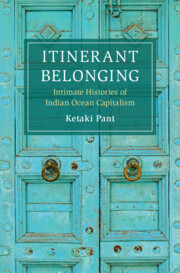Refine search
Actions for selected content:
146 results
Sino-Japanese Children Born of the Second Sino-Japanese War Who “Returned” to Their “Homeland”: Experiences, Identities, and Belonging – ERRATUM
-
- Journal:
- Asia-Pacific Journal / Volume 23 / 2025
- Published online by Cambridge University Press:
- 23 October 2025, e16
-
- Article
-
- You have access
- Open access
- HTML
- Export citation
Built Forms, Things, and Urban Belonging - Children of the Soil: The Power of Built Form in Urban Madagascar Tasha Rijke-Epstein. Durham, NC: Duke University Press, 2023. Pp. 376. $109.95, hardcover (ISBN: 9781478020486); $29.95, paperback (ISBN: 9781478025290); ebook (ISBN: 9781478027409).
-
- Journal:
- The Journal of African History / Volume 66 / 2025
- Published online by Cambridge University Press:
- 17 September 2025, e14
-
- Article
- Export citation
Sino-Japanese Children Born of the Second Sino-Japanese War Who “Returned” to Their “Homeland”: Experiences, Identities, and Belonging
-
- Journal:
- Asia-Pacific Journal / Volume 23 / 2025
- Published online by Cambridge University Press:
- 19 August 2025, e13
-
- Article
-
- You have access
- Open access
- HTML
- Export citation
6 - Language Ideologies of Belonging
- from Part II - Constructing Languages through Discourses on Belonging, Prestige, and Materiality
-
- Book:
- Liquid Languages
- Published online:
- 28 July 2025
- Print publication:
- 14 August 2025, pp 93-125
-
- Chapter
- Export citation
Chapter 4 - Definition of School Adjustment
-
- Book:
- School Adjustment
- Published online:
- 29 August 2025
- Print publication:
- 07 August 2025, pp 59-87
-
- Chapter
- Export citation
Death of the Gharīb: A Window towards a Regional Understanding of Displacement in the Middle East
-
- Journal:
- Comparative Studies in Society and History / Volume 67 / Issue 4 / October 2025
- Published online by Cambridge University Press:
- 17 July 2025, pp. 761-784
-
- Article
-
- You have access
- Open access
- HTML
- Export citation
Chapter 15 - Afterword
-
- Book:
- The Pattern of Change
- Published online:
- 17 June 2025
- Print publication:
- 03 July 2025, pp 552-561
-
- Chapter
- Export citation
Chapter 8 - Adolescents and Cults
- from Section 2 - Confounding Factors and Special Populations
-
-
- Book:
- A Clinical and Forensic Guide to Cults and Persuasive Leadership
- Published online:
- 19 June 2025
- Print publication:
- 03 July 2025, pp 141-152
-
- Chapter
- Export citation
Chapter 15 - Conclusion
- from Part V - Integration and Conclusion
-
- Book:
- The Development and Organization of Meaning
- Published online:
- 11 June 2025
- Print publication:
- 26 June 2025, pp 201-207
-
- Chapter
- Export citation
9 - Social cultures and belonging
-
- Book:
- Intentional Practice with Infants and Toddlers
- Published online:
- 17 June 2025
- Print publication:
- 12 June 2025, pp 227-254
-
- Chapter
- Export citation
The impact of L2 Spanish learners’ attitudes toward Spanish sociophonetic variation on use and belonging
-
- Journal:
- Language Teaching , First View
- Published online by Cambridge University Press:
- 15 May 2025, pp. 1-4
-
- Article
- Export citation
Introduction
-
- Book:
- Itinerant Belonging
- Published online:
- 10 April 2025
- Print publication:
- 17 April 2025, pp 4-35
-
- Chapter
- Export citation

Itinerant Belonging
- Intimate Histories of Indian Ocean Capitalism
-
- Published online:
- 10 April 2025
- Print publication:
- 17 April 2025
Enhancing engagement in workplace belonging efforts: Why moral processes matter
-
- Journal:
- Industrial and Organizational Psychology / Volume 18 / Issue 2 / June 2025
- Published online by Cambridge University Press:
- 20 March 2025, pp. 236-253
-
- Article
-
- You have access
- Open access
- HTML
- Export citation
Towards a grammar of theocentric belonging: Kilby, Tanner and beyond
-
- Journal:
- Scottish Journal of Theology / Volume 78 / Issue 3 / August 2025
- Published online by Cambridge University Press:
- 06 March 2025, pp. 229-239
- Print publication:
- August 2025
-
- Article
- Export citation
Chapter 16 - Plants in the Literatures of Southern Africa
- from Part III - Global Regions
-
-
- Book:
- The Cambridge Handbook of Literature and Plants
- Published online:
- 06 February 2025
- Print publication:
- 13 February 2025, pp 304-324
-
- Chapter
- Export citation
The Incluseum Manifesto for the Humanities in the Public Sphere
- Part of
-
- Journal:
- Public Humanities / Volume 1 / 2025
- Published online by Cambridge University Press:
- 28 January 2025, e44
-
- Article
-
- You have access
- Open access
- HTML
- Export citation
Cosmology of belonging: The role of community in the therapeutic use of psychedelics
-
- Journal:
- Palliative & Supportive Care / Volume 23 / 2025
- Published online by Cambridge University Press:
- 21 January 2025, e27
-
- Article
-
- You have access
- Open access
- HTML
- Export citation
5 - Constructing Belonging and Contesting Economic Space
-
- Book:
- Millennial Dreams in Oil Economies
- Published online:
- 02 January 2025
- Print publication:
- 09 January 2025, pp 203-241
-
- Chapter
- Export citation
15 - Shifting Borders, Shifting Political Representation
- from Part IV - Democratizing Shifting Borders
-
-
- Book:
- Lawless Zones, Rightless Subjects
- Published online:
- 02 January 2025
- Print publication:
- 09 January 2025, pp 264-279
-
- Chapter
-
- You have access
- Open access
- HTML
- Export citation
